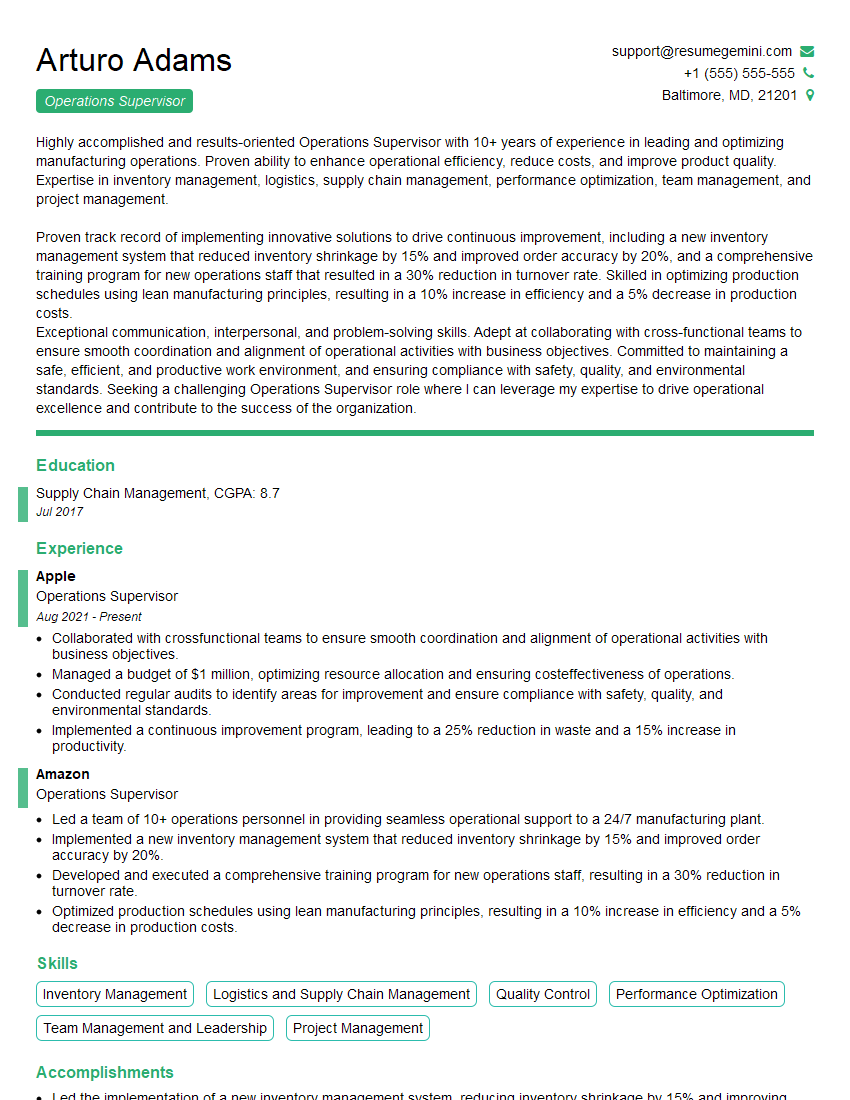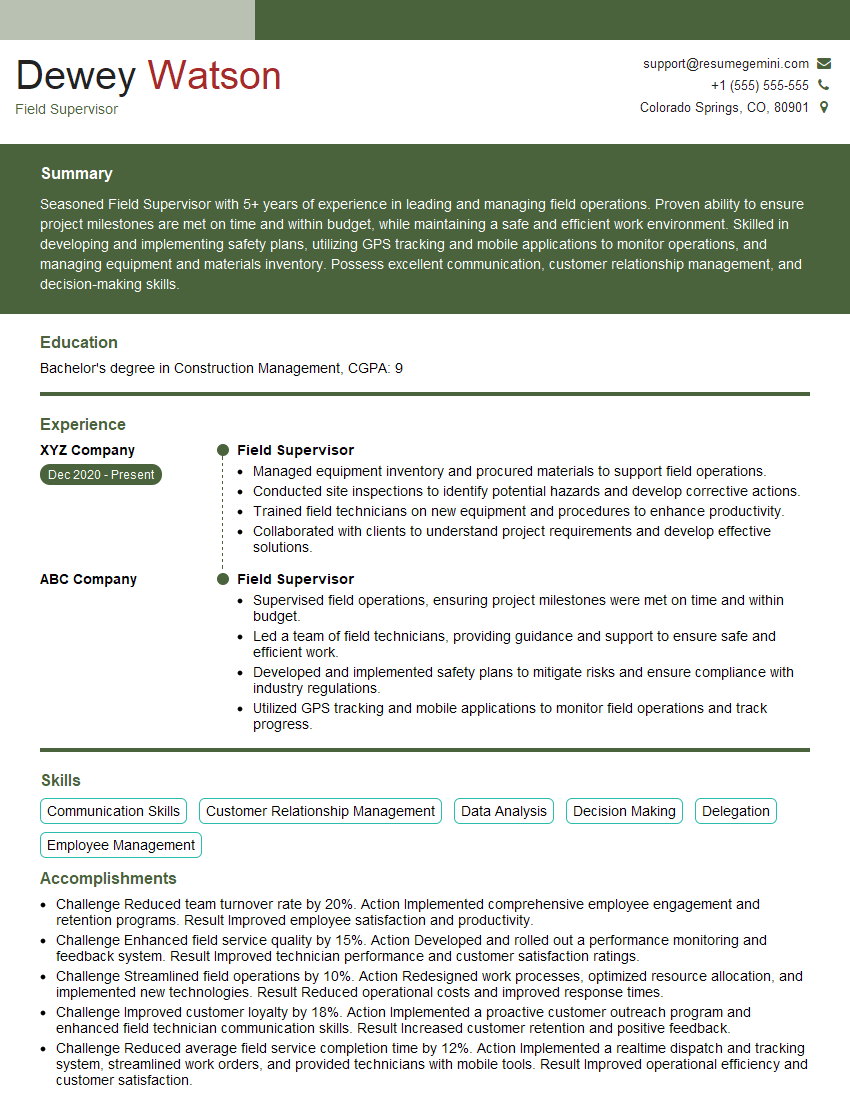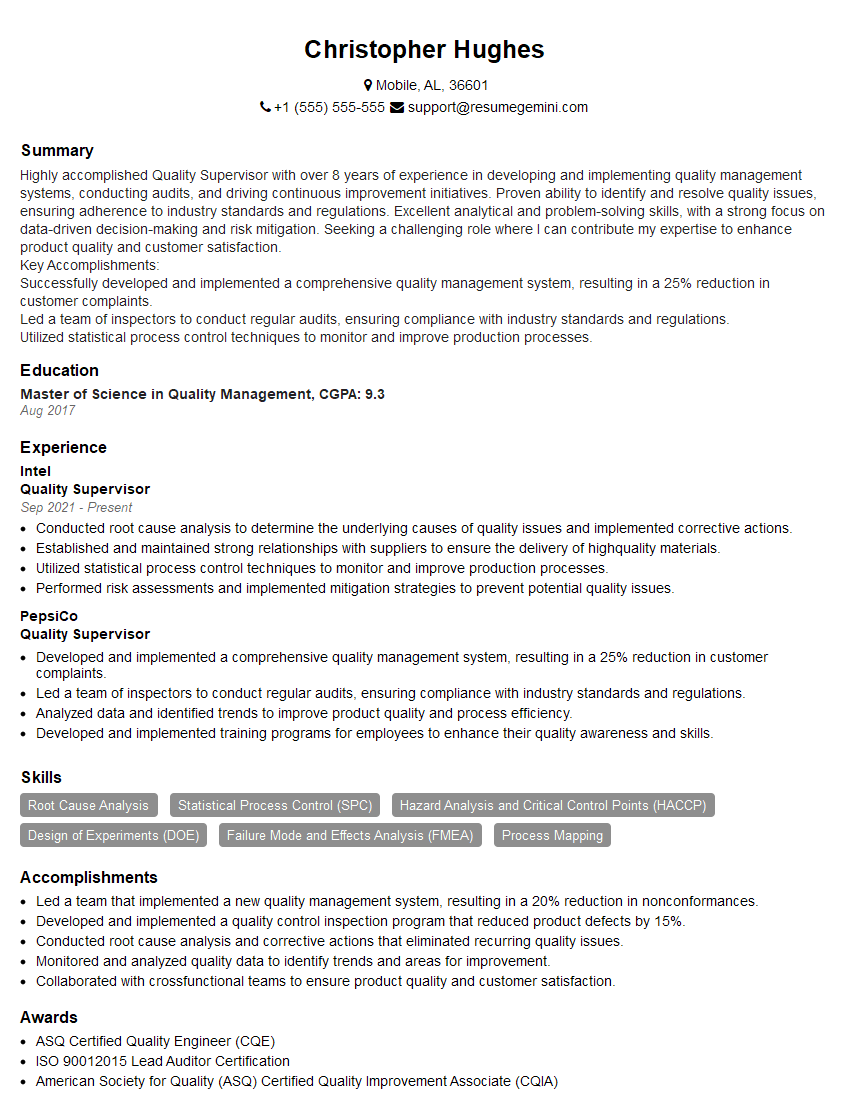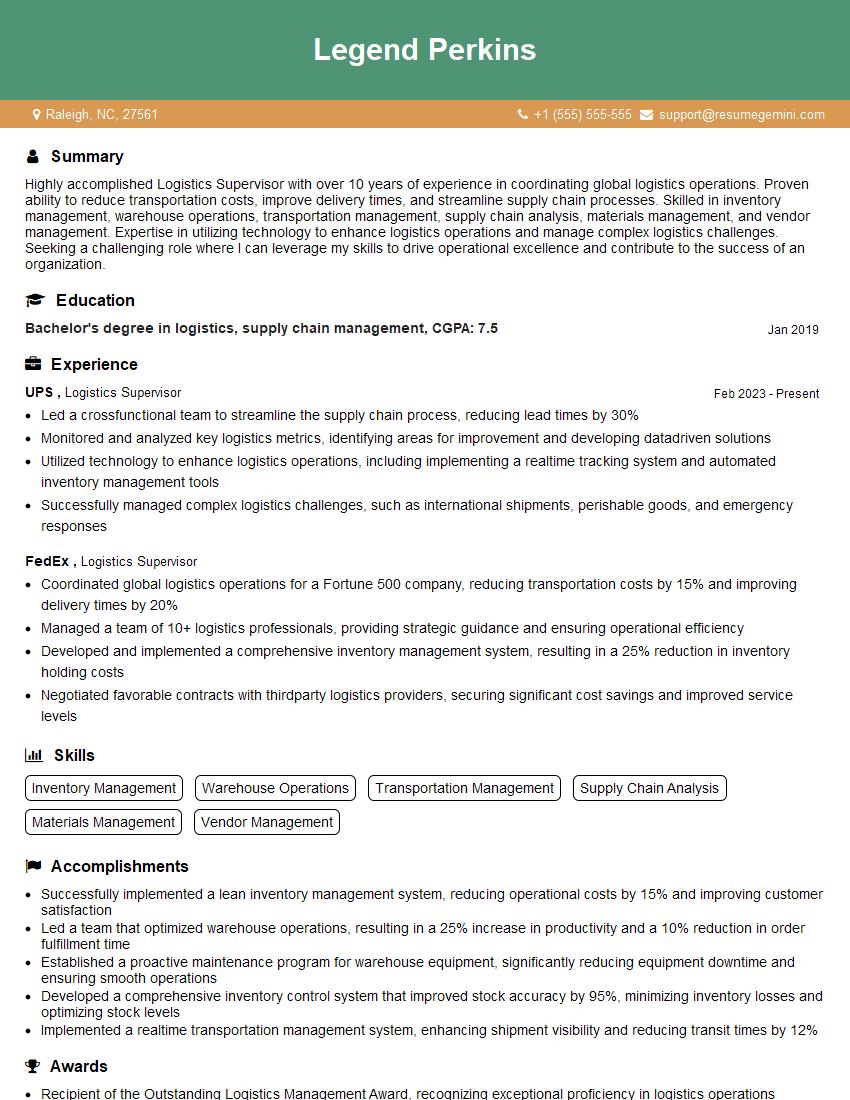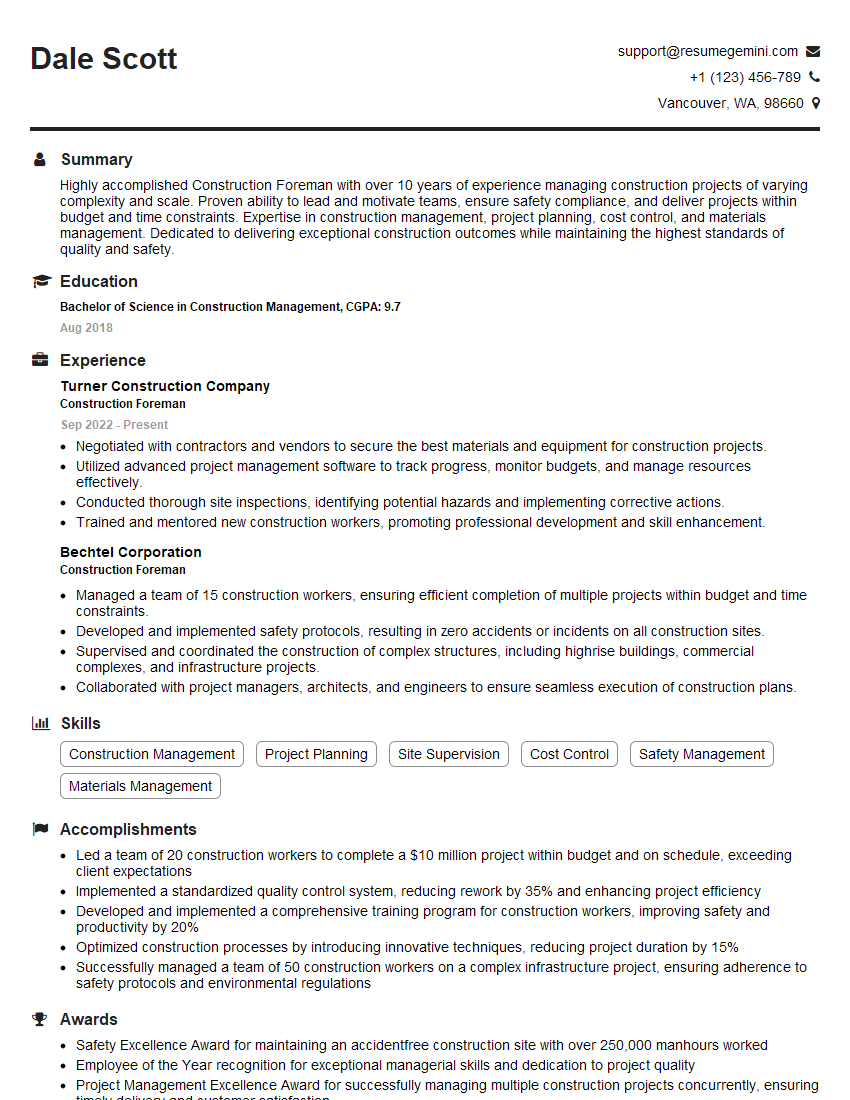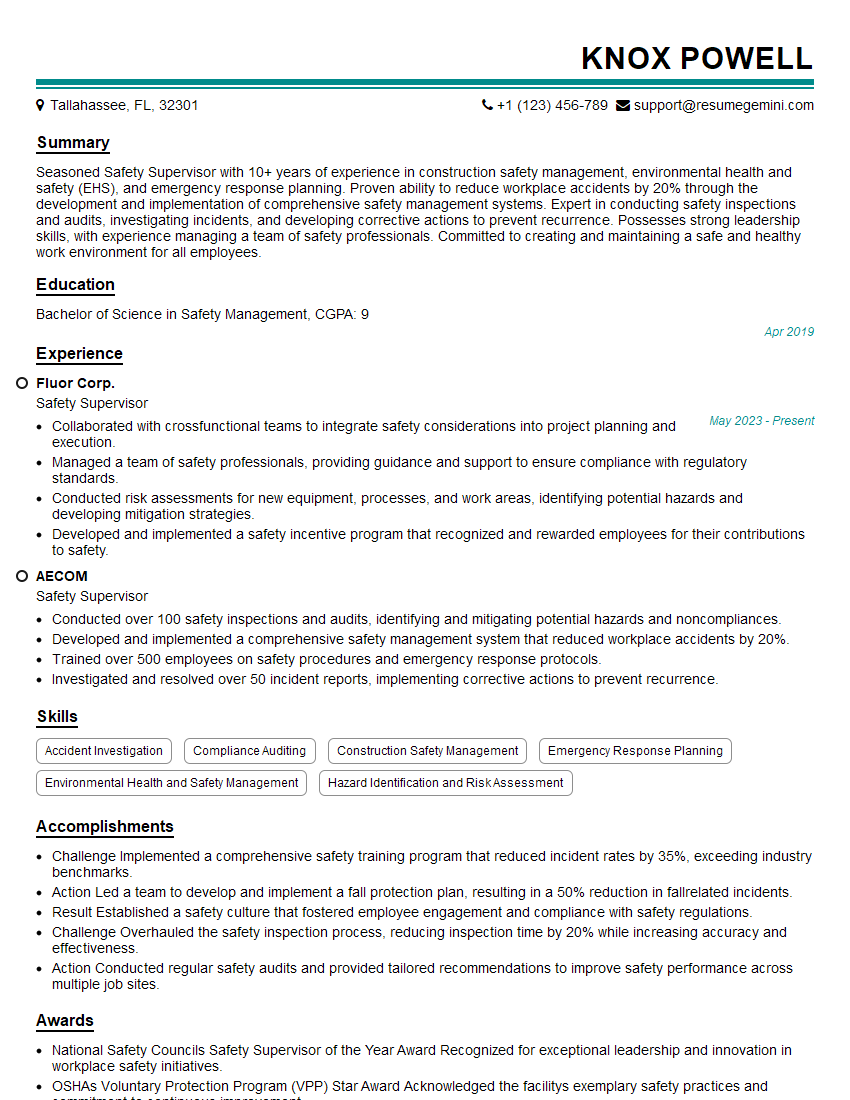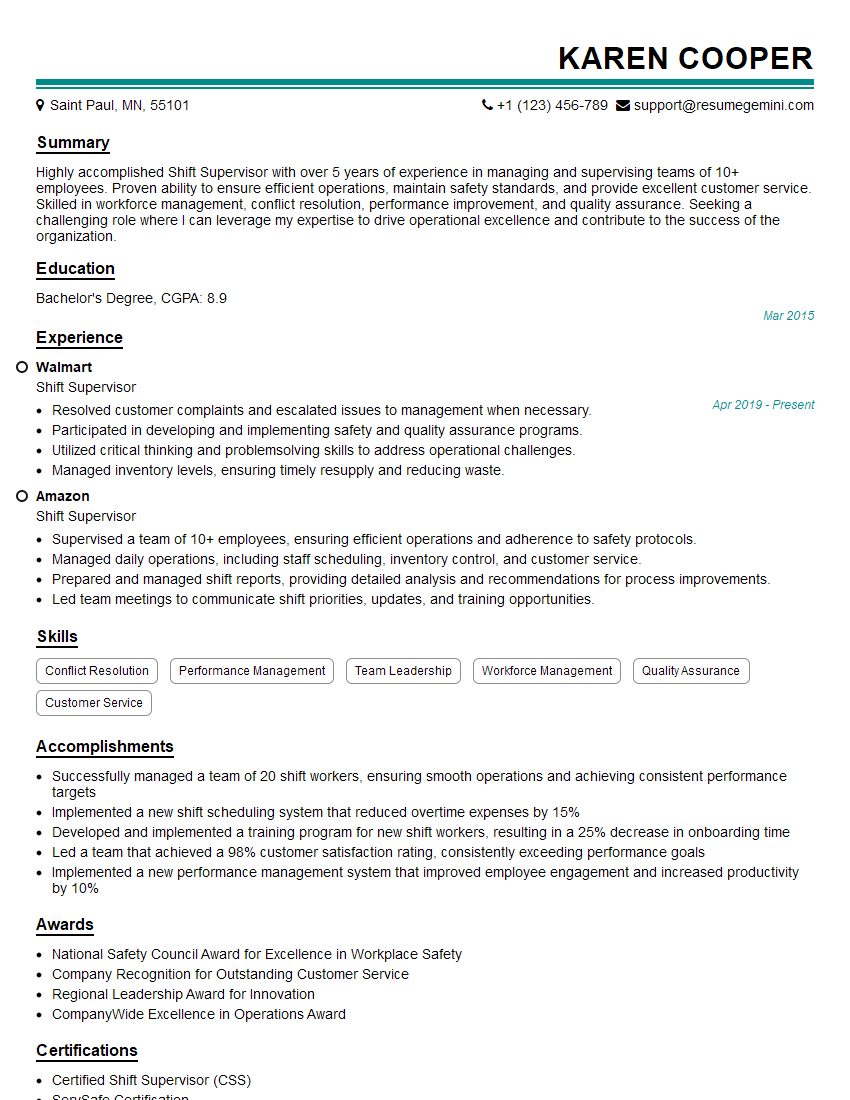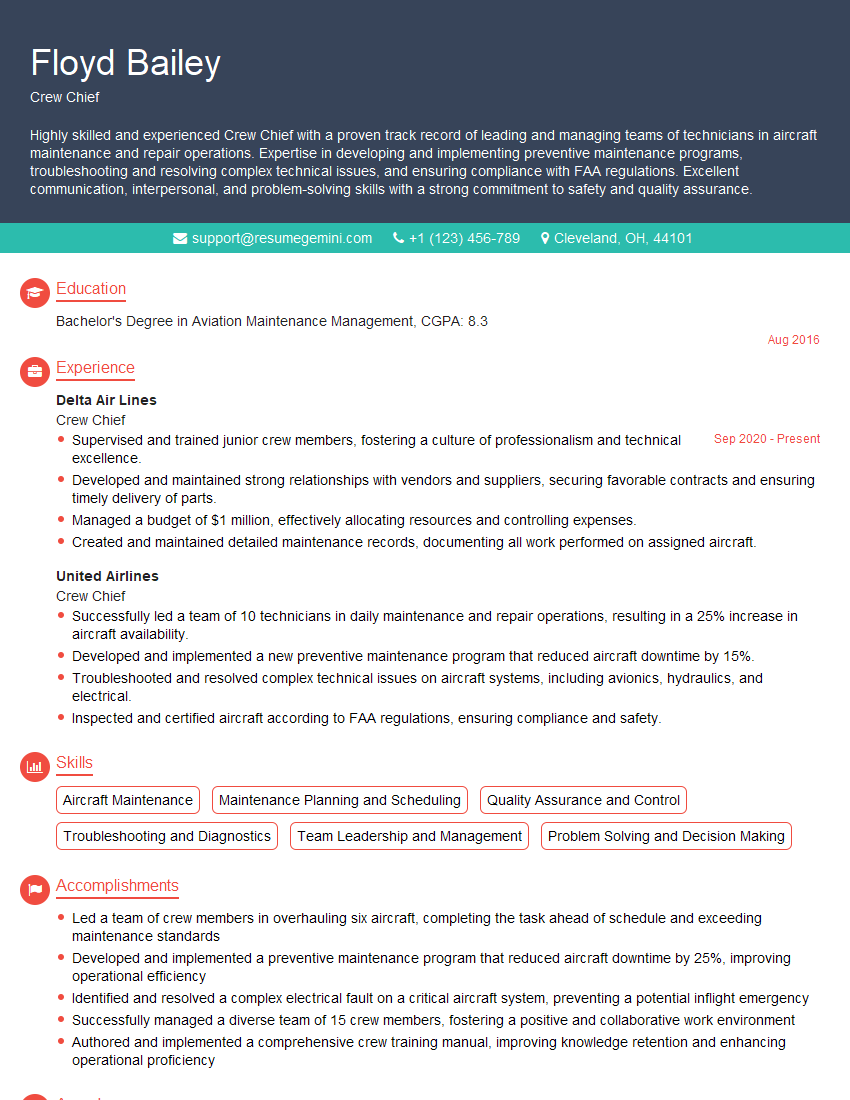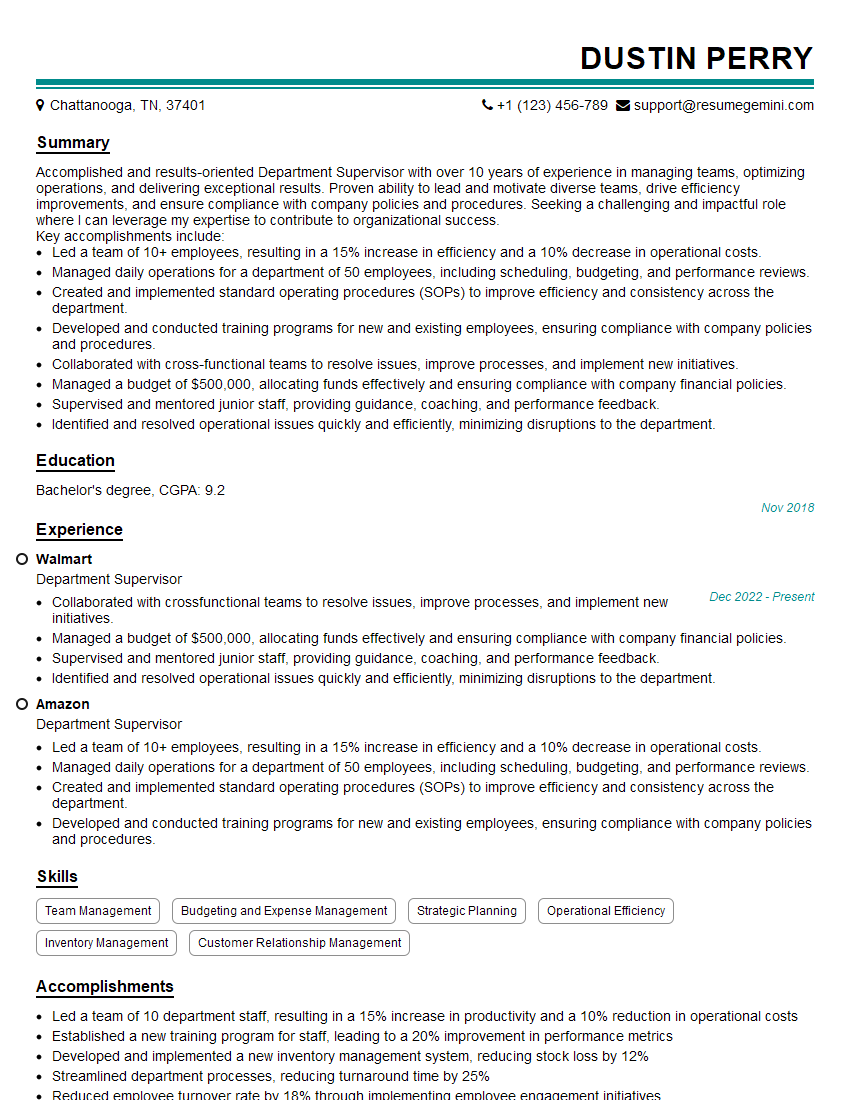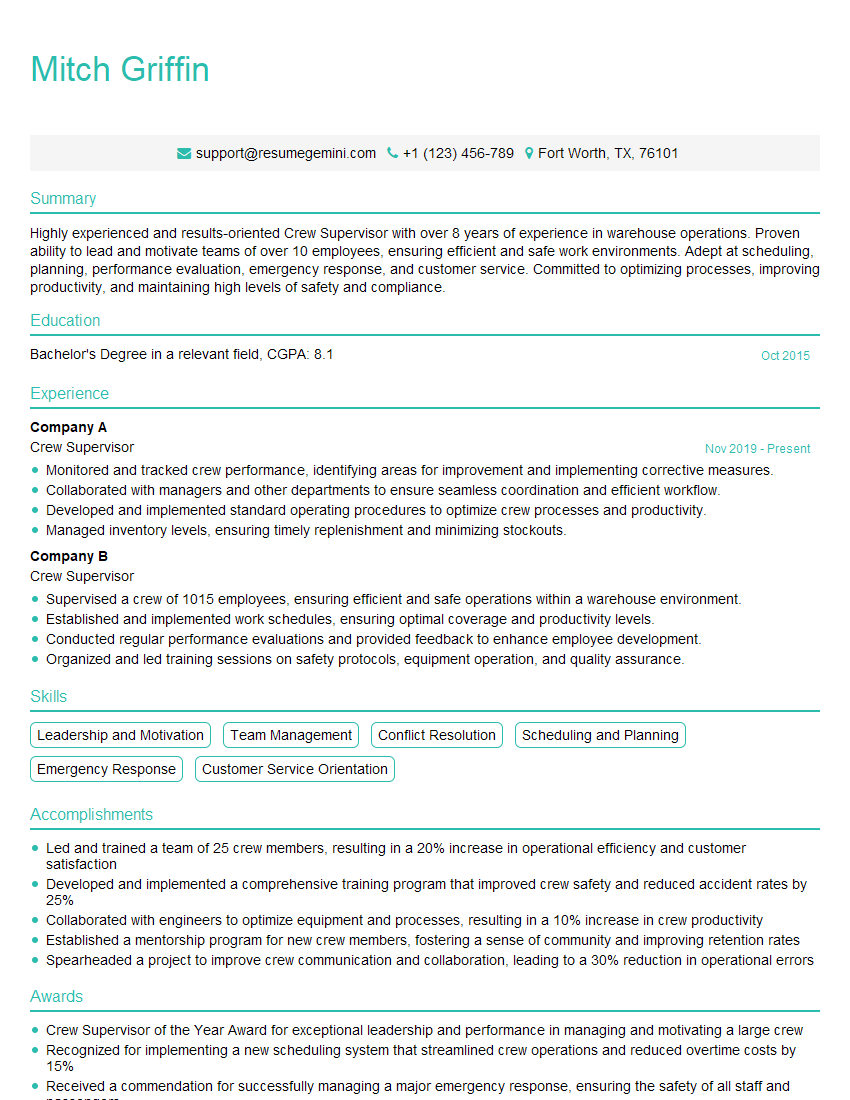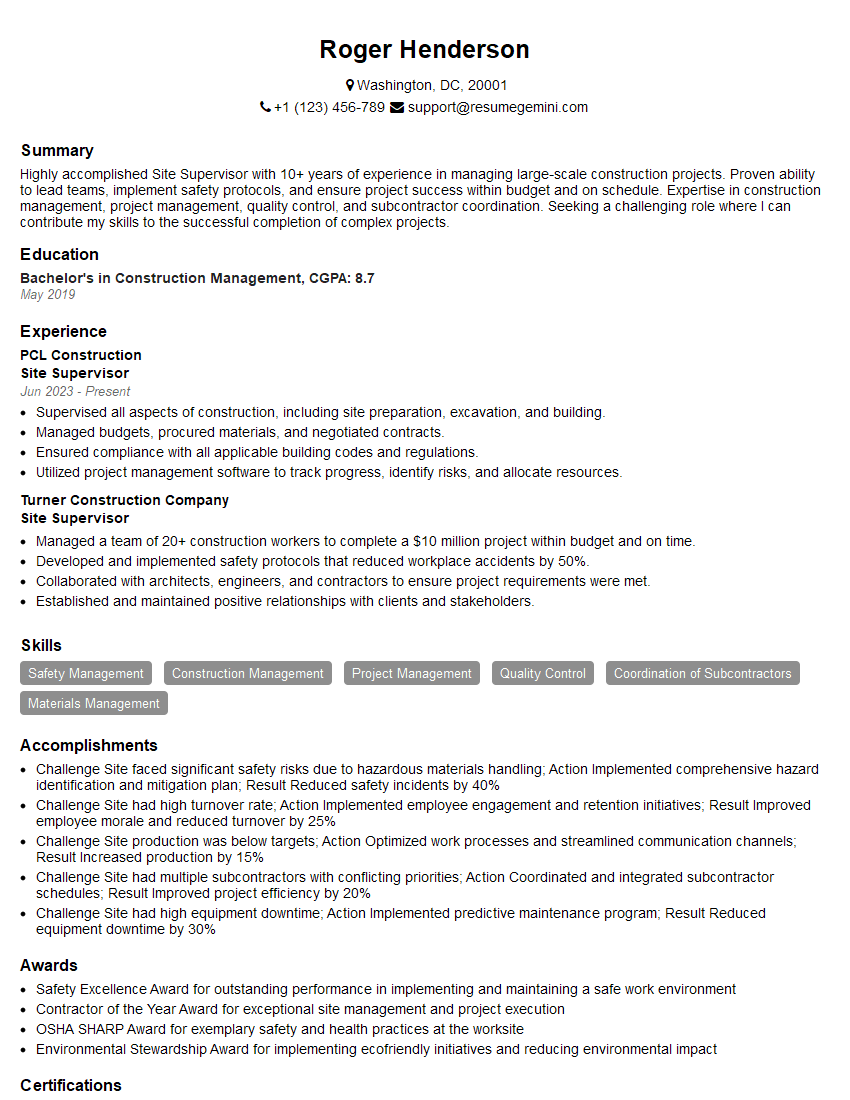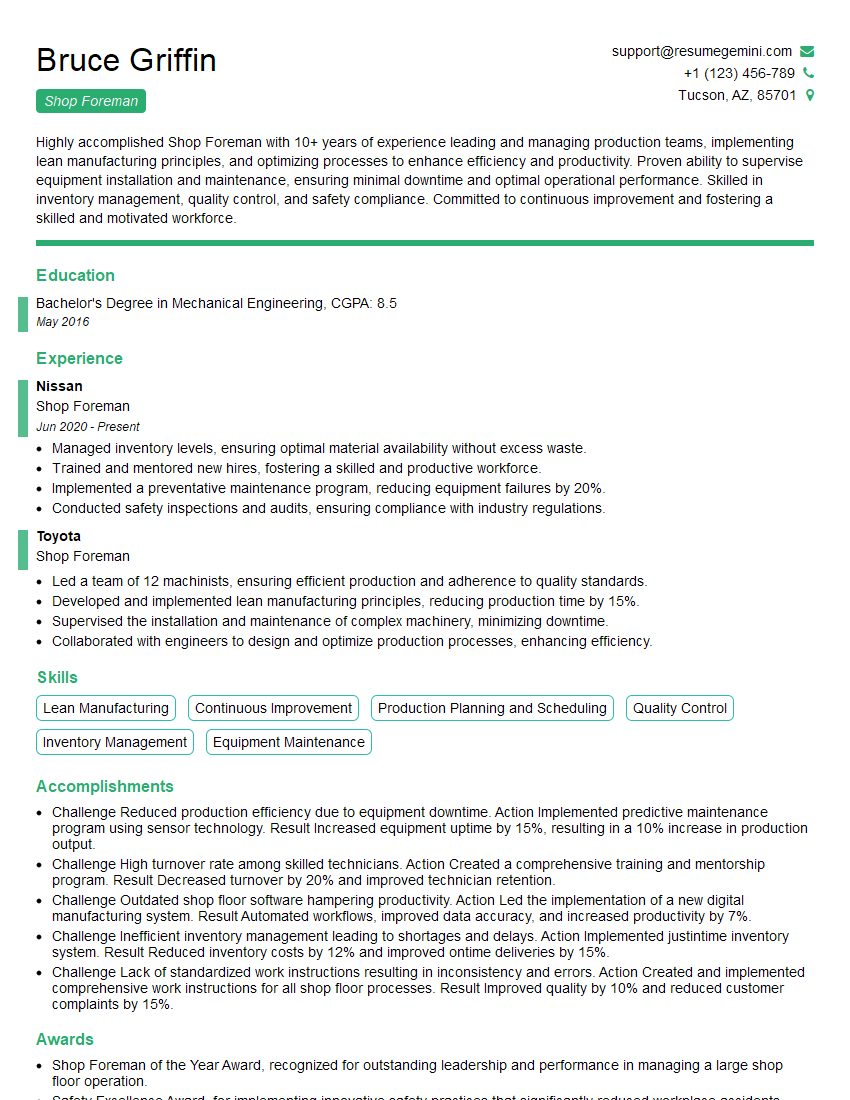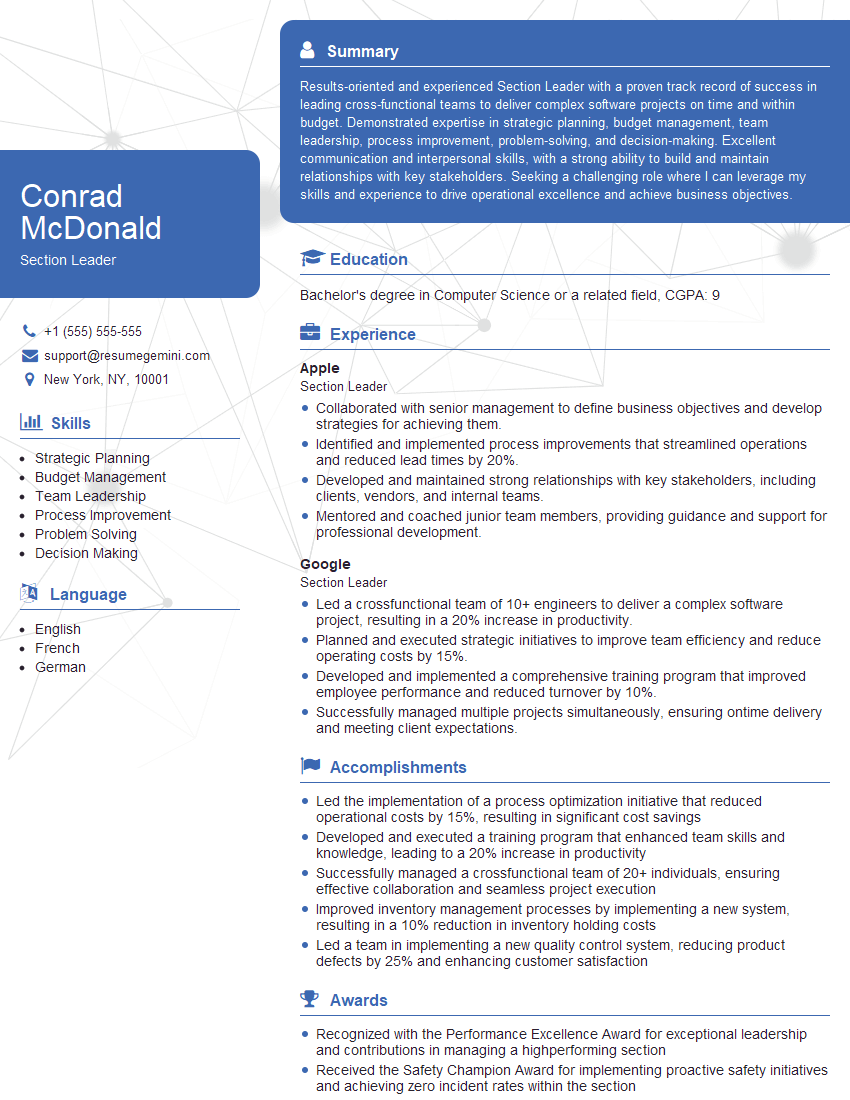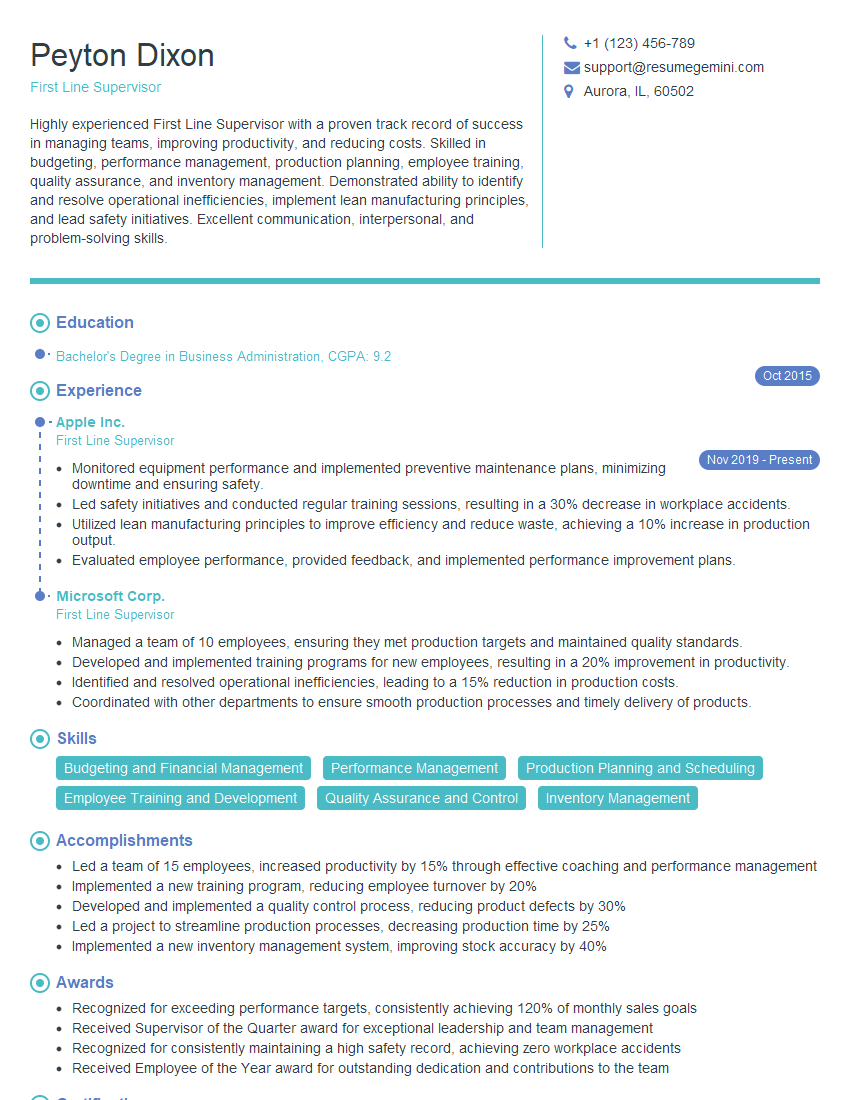The right preparation can turn an interview into an opportunity to showcase your expertise. This guide to Crew Supervision and Leadership interview questions is your ultimate resource, providing key insights and tips to help you ace your responses and stand out as a top candidate.
Questions Asked in Crew Supervision and Leadership Interview
Q 1. Describe your experience managing a team of diverse individuals.
Managing diverse teams is about leveraging individual strengths and fostering a culture of inclusivity. It’s not just about acknowledging differences; it’s about actively utilizing them to achieve shared goals. My approach involves understanding individual work styles, communication preferences, and cultural backgrounds. I create opportunities for team members to share their perspectives, ensuring everyone feels heard and valued. For example, during a project involving a diverse team of engineers from different countries, I facilitated regular brainstorming sessions using a structured approach that ensured everyone had equal opportunity to contribute. I also made sure to utilize different communication channels – some team members preferred email, others instant messaging, and some preferred face-to-face meetings – to ensure optimal communication and collaboration.
Additionally, I actively work to address any potential biases or misunderstandings. This might involve providing diversity and inclusion training, establishing clear communication protocols, and actively promoting a culture of respect. Ultimately, a truly diverse team is a powerful one – but only when the management team takes proactive steps to harness its strengths.
Q 2. How do you motivate a team to achieve challenging goals?
Motivating a team to achieve challenging goals requires a multi-faceted approach that goes beyond simply setting targets. It’s about inspiring commitment and fostering a sense of shared purpose. I start by clearly articulating the goal, its importance, and how individual contributions contribute to the overall success. This is followed by setting SMART (Specific, Measurable, Achievable, Relevant, Time-bound) goals – making progress transparent and measurable.
Then, I foster a culture of recognition and reward, celebrating both individual and team achievements. Open communication is crucial; regular team meetings, both formal and informal, provide opportunities for feedback, updates, and problem-solving. I encourage collaboration and peer-to-peer support, creating a team environment where everyone feels empowered to contribute and succeed. Finally, I provide the team with the necessary resources and support, addressing any obstacles or roadblocks promptly. For example, when facing a particularly aggressive deadline, I facilitated extra training sessions for the team to improve their efficiency, and also secured additional resources to lighten the workload.
Q 3. Explain your approach to conflict resolution within a crew.
Conflict resolution is a crucial skill for any crew supervisor. My approach is proactive and focuses on early intervention. I encourage open communication, creating a safe space where team members feel comfortable expressing their concerns. When conflict arises, I facilitate a discussion focused on understanding each individual’s perspective. I avoid taking sides and strive to identify the root cause of the conflict, rather than focusing on assigning blame.
I then work collaboratively with the team to develop mutually agreeable solutions. This often involves brainstorming options and identifying compromises. If needed, I will mediate, ensuring fair and equitable outcomes. Documentation is vital; key discussions and agreements are recorded. For example, I once successfully resolved a conflict between two crew members over scheduling using a collaborative calendar and clearly defining responsibilities. This prevented further conflicts and improved overall team dynamics.
Q 4. How do you delegate tasks effectively to maximize team productivity?
Effective delegation is about matching the right task to the right person based on their skills, experience, and availability. It’s not just about distributing work; it’s about empowering individuals to take ownership and develop their capabilities. Before delegating, I clearly define the task, expected outcomes, deadlines, and required resources. I provide adequate training and support, ensuring the team member understands their responsibilities and has the tools they need to succeed.
I also set clear expectations for communication and reporting, ensuring regular check-ins to monitor progress and address any challenges. Delegation involves trust and empowerment; I empower my team members to make decisions within their scope of responsibility, fostering their independence and problem-solving skills. For example, I once delegated a complex problem-solving task to a junior team member, providing them with the necessary mentoring and support, resulting in them exceeding expectations and gaining valuable experience.
Q 5. What strategies do you use to monitor team performance and identify areas for improvement?
Monitoring team performance is an ongoing process that involves a variety of methods. I utilize a combination of quantitative and qualitative data to gain a comprehensive understanding of team effectiveness. Quantitative data might include metrics like project completion rates, error rates, or productivity levels. Qualitative data is gathered through regular team meetings, one-on-one check-ins, and performance reviews. Feedback from both team members and clients provides valuable insights.
I also employ observation techniques to assess teamwork, communication, and problem-solving skills in real-time. Once potential areas for improvement are identified, I facilitate discussions with the team to address these issues collaboratively. This might involve additional training, process improvements, or adjustments to team roles and responsibilities. Regular performance reviews help individuals track their progress, providing opportunities for development and growth.
Q 6. Describe a time you had to address a safety violation within your crew.
Addressing safety violations is paramount. In one instance, a team member was observed not wearing the required safety harness while working at height. I immediately intervened, stopping the work and reminding the team member of the company’s safety protocols. I then conducted a thorough discussion emphasizing the seriousness of the violation and the potential consequences, including injury or even fatality. The team member’s explanation was heard, and we addressed any underlying causes contributing to the lapse.
Further, I conducted a brief training session for the entire crew to reinforce safety procedures and to foster a culture of proactive safety awareness. The incident was documented, following company protocol, and corrective actions were implemented to prevent recurrence. Safety is never compromised, and immediate and decisive action is always prioritized.
Q 7. How do you ensure consistent communication within your team?
Consistent communication is the cornerstone of an effective team. I use a multi-channel approach, combining various methods to reach every team member effectively. This includes regular team meetings, both formal and informal, to discuss progress, address concerns, and share information. Instant messaging tools are used for quick updates and questions, while email is used for official communications and documentation.
I also encourage open and transparent communication, ensuring that information flows freely within the team. This includes actively soliciting feedback and promoting a culture of open dialogue. Regularly scheduled one-on-one meetings provide opportunities for individual check-ins and personalized feedback. To ensure clarity, I use visual aids such as diagrams and charts to communicate complex information effectively. By employing diverse communication strategies, I maintain a consistent and clear flow of information throughout the team.
Q 8. How do you handle difficult team members or interpersonal conflicts?
Addressing difficult team members or interpersonal conflicts requires a proactive and empathetic approach. My strategy focuses on open communication, active listening, and finding mutually agreeable solutions. I begin by privately speaking with each involved individual to understand their perspectives, ensuring a safe space for them to express their concerns without interruption. I then facilitate a structured meeting where everyone involved can voice their opinions and collaborate on a resolution. This meeting isn’t about assigning blame, but about finding common ground and establishing clear expectations moving forward. For example, if two team members are constantly clashing over workflow, I might introduce a new system for task allocation or a regular check-in process to prevent misunderstandings. If the conflict is rooted in personality differences, I may suggest conflict resolution training or mentorship opportunities. The key is to address the issue directly, promote understanding, and implement strategies to prevent recurrence.
Q 9. What is your approach to providing constructive feedback to team members?
Constructive feedback is crucial for employee growth and improved performance. My approach follows the SBI (Situation-Behavior-Impact) model. I start by describing the specific situation where the behavior occurred, focusing on observable actions rather than subjective interpretations. Then, I clearly outline the specific behavior that needs improvement, using concrete examples. Finally, I explain the impact of that behavior on the team, project, or company. For instance, instead of saying ‘You’re not a team player,’ I might say, ‘During the last project, you didn’t contribute to the team brainstorming session (Situation). You didn’t share your ideas or actively listen to others’ suggestions (Behavior). This resulted in a less effective plan and increased the workload on others (Impact).’ I always end the feedback session with a collaborative discussion on how to improve, focusing on solutions and support rather than criticism. The goal is to guide team members toward self-improvement and enhance their performance.
Q 10. How do you manage team morale and maintain a positive work environment?
Maintaining high team morale and a positive work environment is essential for productivity and job satisfaction. I believe in fostering a culture of mutual respect, appreciation, and open communication. I regularly acknowledge and celebrate team achievements, both big and small. This could be through informal praise, team lunches, or formal recognition programs. I also encourage teamwork through collaborative projects and team-building activities. These activities aren’t just for fun; they help build trust and camaraderie. Furthermore, I actively solicit feedback from my team members, creating channels for them to voice concerns and suggestions. Addressing these issues promptly shows that their opinions are valued. I also prioritize work-life balance and provide opportunities for professional development, which demonstrates a commitment to their well-being and career growth. A positive and supportive environment motivates employees and boosts their overall job satisfaction.
Q 11. How do you handle pressure and tight deadlines while supervising a crew?
Handling pressure and tight deadlines requires strong organizational skills, effective communication, and a proactive approach. When faced with a challenging situation, I first prioritize tasks based on urgency and importance, using tools like project management software to track progress. Open communication is key; I keep my team informed about deadlines and potential challenges, ensuring everyone understands their roles and responsibilities. I break down large tasks into smaller, manageable steps to avoid feeling overwhelmed. When necessary, I may need to delegate tasks effectively, based on individual skills and expertise. Additionally, I focus on maintaining a calm and supportive demeanor to avoid creating unnecessary stress among the team. I also ensure that we have the necessary resources and support to meet the deadlines, addressing any obstacles proactively.
Q 12. Describe your experience with performance reviews and employee development.
Performance reviews are a crucial part of employee development. I conduct regular one-on-one meetings with each team member to discuss their progress, achievements, and areas for improvement. These reviews aren’t solely focused on evaluation; they provide a platform for constructive feedback and goal setting. I use a combination of quantitative data (e.g., project completion rates) and qualitative assessments (e.g., observations of teamwork and problem-solving skills) to provide a comprehensive evaluation. Following the review, I create a personalized development plan with clear, measurable, achievable, relevant, and time-bound (SMART) goals. This plan outlines specific training opportunities, mentorship programs, or other resources to help the employee develop their skills and advance their career. I follow up regularly to monitor progress and provide ongoing support.
Q 13. What are your strategies for training new crew members?
Training new crew members involves a structured and supportive approach. I start with a comprehensive orientation that covers company policies, safety regulations, and the overall work environment. Then, I provide hands-on training, starting with simple tasks and gradually increasing complexity as they gain proficiency. I use a combination of demonstration, observation, and practice, providing regular feedback and encouragement. Mentorship is a crucial part of the training process; I assign experienced team members to guide and support new hires. Regular check-ins allow me to monitor progress, address any challenges, and provide additional support. Finally, I encourage open communication, creating a safe space for new hires to ask questions and seek clarification. A well-trained crew is a productive and efficient crew.
Q 14. How do you ensure compliance with company policies and procedures?
Ensuring compliance with company policies and procedures is paramount. I begin by clearly communicating these policies and procedures to all team members during their onboarding and through regular training sessions. I regularly review and update the team on any changes or additions. I utilize various methods to reinforce compliance, such as regular safety briefings, checklists, and documentation of all activities. I also use technology to streamline processes and minimize human error where possible. In cases where non-compliance is identified, I address it promptly and fairly, providing corrective actions and additional training as needed. A strong emphasis on safety and compliance minimizes risks and ensures a smooth workflow. Regular audits and self-assessments are also conducted to evaluate our adherence to company guidelines and identify areas for improvement.
Q 15. Describe a time you had to make a quick, critical decision impacting your team.
Quick, critical decisions are a regular part of crew supervision. One instance involved a sudden equipment malfunction during a crucial phase of a construction project. Our crane experienced a hydraulic failure, leaving a precast concrete panel suspended mid-air. The decision was immediate: prioritize safety and initiate emergency procedures.
My immediate actions were threefold: 1) I secured the area, evacuating all personnel from the immediate vicinity. 2) I contacted the on-site safety officer and initiated the emergency response protocol. 3) I calmly communicated the situation and next steps to my crew, emphasizing calm and following established procedures. Luckily, the emergency procedures worked flawlessly and the panel was secured without incident. The quick thinking and reliance on well-defined safety protocols prevented what could have been a devastating accident.
This experience highlighted the importance of proactive safety measures, clear communication during emergencies, and a well-trained team who knows how to respond to unexpected events. The success hinged on pre-planning and a strong emphasis on safety.
Career Expert Tips:
- Ace those interviews! Prepare effectively by reviewing the Top 50 Most Common Interview Questions on ResumeGemini.
- Navigate your job search with confidence! Explore a wide range of Career Tips on ResumeGemini. Learn about common challenges and recommendations to overcome them.
- Craft the perfect resume! Master the Art of Resume Writing with ResumeGemini’s guide. Showcase your unique qualifications and achievements effectively.
- Don’t miss out on holiday savings! Build your dream resume with ResumeGemini’s ATS optimized templates.
Q 16. How do you handle unexpected events or crises within your crew?
Handling unexpected events requires a structured approach. My strategy hinges on a three-pronged response: Assess, Act, Adapt.
- Assess: Quickly evaluate the situation’s impact, identifying potential risks and consequences. Who’s involved? What’s the immediate danger? What resources are needed?
- Act: Implement immediate actions to mitigate the risk, stabilize the situation, and ensure the safety of my crew. This may involve activating emergency procedures, contacting relevant authorities, or re-allocating personnel.
- Adapt: Once the immediate crisis is addressed, review what happened, identify areas for improvement, and adapt our procedures to prevent similar events in the future. A post-incident analysis is crucial for learning and improvement.
For example, a sudden storm during an outdoor project required immediate action. We assessed the risks of wind and lightning, acted by halting operations and moving personnel to a safe location, and adapted by incorporating weather monitoring into our future project planning.
Q 17. What is your approach to resource allocation and scheduling within your crew?
Resource allocation and scheduling are critical for efficient project execution. My approach is based on a combination of project planning software and close collaboration with the team. We start with a detailed project breakdown, identifying tasks, dependencies, and resource requirements (personnel, equipment, materials).
I utilize project management software (like MS Project or similar) to create a detailed schedule, assigning tasks to individuals based on their skills and availability. This schedule is regularly reviewed and updated to reflect changes, delays, or unexpected events. Regular team meetings ensure everyone is informed and any conflicts or resource constraints are promptly addressed. Visual aids such as Gantt charts help in visualizing task dependencies and timelines. Effective communication is key to prevent conflicts and ensure everyone has the resources they need when they need them.
Q 18. How do you track team progress towards project goals?
Tracking team progress requires a multifaceted approach. We use a combination of methods tailored to the project’s specifics.
- Regular Check-ins: Daily or weekly meetings are crucial for real-time updates and addressing any roadblocks.
- Progress Reports: Team members submit regular progress reports detailing completed tasks, outstanding issues, and projected timelines. This is often facilitated by project management software.
- Visual Dashboards: Visual tools, like Kanban boards or progress charts, provide a clear, at-a-glance view of the overall project status and individual task progress.
- Key Performance Indicators (KPIs): We establish relevant KPIs specific to the project (e.g., units produced per day, completion rate, defect rate) to measure progress against established targets.
By combining these methods, we get a comprehensive picture of progress, allowing for proactive adjustments and course correction as needed.
Q 19. Describe your experience using performance management tools or software.
My experience with performance management tools includes using various software solutions such as Asana, Trello, and Monday.com for task management and progress tracking. These tools are invaluable for monitoring individual and team performance, identifying bottlenecks, and facilitating communication. Beyond software, I’ve used more traditional methods like performance review forms, 360-degree feedback processes, and regular one-on-one meetings to assess individual contributions and identify areas for growth.
These tools are not just for tracking performance but also for facilitating constructive feedback and creating a culture of continuous improvement. It’s essential to understand that these tools are just supporting mechanisms; the core of effective performance management is open communication, regular feedback, and a focus on employee development.
Q 20. How do you measure the success of your crew?
Measuring crew success goes beyond just completing tasks on time and within budget. It’s about achieving the project goals while maintaining high standards of quality, safety, and team morale. We use a balanced scorecard approach, considering:
- Project Outcomes: Were the project goals achieved? Did we deliver the expected results on time and within budget?
- Quality of Work: Did the work meet quality standards? Were there any defects or rework required?
- Safety Record: Did we maintain a safe work environment, with minimal incidents or accidents?
- Team Morale and Collaboration: Was the team working effectively together? Was there good communication and collaboration?
By considering these various factors, we gain a holistic understanding of the crew’s performance and identify areas for improvement. A successful crew is not just productive, but also safe, collaborative, and motivated.
Q 21. What safety procedures do you enforce on your crew?
Safety is paramount. Our crew adheres to a strict set of safety procedures, incorporating regular training, risk assessments, and robust emergency protocols.
- Pre-Task Safety Briefings: Before commencing any task, a safety briefing is conducted to address potential hazards and ensure everyone understands the safe work practices.
- Personal Protective Equipment (PPE): Appropriate PPE is mandatory and regularly inspected to ensure it’s in good working order.
- Regular Safety Audits: Work areas are regularly inspected for hazards, and corrective actions are promptly implemented.
- Emergency Response Plan: We have a clearly defined emergency response plan which is regularly practiced and updated. This includes procedures for medical emergencies, fire, hazardous material spills, and equipment malfunctions.
- Incident Reporting and Investigation: All incidents, however minor, are reported, investigated, and reviewed to identify root causes and prevent recurrences.
Our emphasis on safety isn’t just about complying with regulations; it’s about fostering a culture of safety awareness and responsibility, ensuring everyone goes home safe at the end of the day.
Q 22. How do you handle complaints or grievances from crew members?
Addressing crew member complaints requires a structured, empathetic approach. My first step is to listen actively and without interruption, ensuring the individual feels heard and valued. I then clarify the complaint, asking open-ended questions to understand the root cause. This avoids assumptions and ensures I’m addressing the genuine issue. Next, I collaborate with the crew member to find a mutually acceptable solution. This might involve adjusting schedules, addressing equipment concerns, or clarifying expectations. Finally, I document the complaint, the solution, and any follow-up actions to ensure accountability and prevent similar issues. For instance, if a complaint involves a faulty tool, I would immediately report it for repair and ensure a replacement is provided in the meantime. If it’s a scheduling conflict, I might work with other supervisors to find a fair solution that accommodates everyone’s needs.
Q 23. How do you build trust and rapport with your crew members?
Building trust and rapport is fundamental to effective crew supervision. I foster this by consistently demonstrating fairness, respect, and open communication. This includes regular team meetings where I solicit feedback, address concerns, and share relevant information. I also prioritize recognizing and rewarding good work and initiative, acknowledging individual contributions to the team’s success. Furthermore, I strive to lead by example, demonstrating the same work ethic and commitment I expect from my crew. Building personal connections outside of work, when appropriate and professional, can also strengthen relationships. For example, a casual team lunch after a successful project can foster a sense of camaraderie and strengthen bonds. Ultimately, it’s about creating a safe and inclusive environment where crew members feel comfortable expressing themselves and contributing their ideas.
Q 24. What is your experience with different leadership styles?
My experience encompasses various leadership styles, and I believe adaptability is key. I’ve utilized a transformational leadership style, inspiring and motivating my crew through shared vision and empowerment. This approach is effective for projects requiring innovation and significant change. I’ve also employed a democratic style, encouraging input and participation from team members in decision-making. This is particularly valuable when tackling complex problems requiring diverse perspectives. In situations demanding swift action and clear direction, a directive style has proven effective. Finally, a servant leadership approach, where I prioritize the needs and development of my team, has been crucial in fostering a positive and supportive work environment. The choice of leadership style isn’t about personal preference, but rather about selecting the approach best suited to the specific situation and the needs of the crew.
Q 25. Describe a time you had to adapt your leadership style to a specific situation.
During a particularly challenging project with tight deadlines and unexpected equipment malfunctions, I had to shift from my usual collaborative, democratic style to a more directive approach. Initially, I tried to involve the entire team in brainstorming solutions, but the constant setbacks and time constraints were hindering progress. Recognizing this, I temporarily took a more hands-on, directive role, assigning specific tasks and providing clear instructions. This ensured quick action and prevented further delays. Once the immediate crisis was resolved, I transitioned back to a more collaborative style, debriefing with the team, acknowledging their contributions, and incorporating their feedback for future projects. This adaptive approach ensured both efficiency and team morale.
Q 26. How do you ensure your team is well-equipped and has the necessary resources?
Ensuring my team is well-equipped involves proactive planning and communication. This includes regular equipment inspections and maintenance schedules to prevent breakdowns. I work closely with procurement to anticipate and address resource needs, ensuring sufficient inventory of essential tools and materials. Furthermore, I proactively seek training opportunities for my crew to enhance their skills and competence. This may involve internal workshops or external courses depending on the team’s specific needs. I also advocate for the provision of necessary safety equipment and ensure everyone receives thorough safety training, consistently reinforcing safe work practices. For example, before starting a project involving heights, I’d ensure everyone has proper fall protection equipment and has been properly trained in its use.
Q 27. How do you maintain a balance between task-oriented and relationship-oriented leadership?
Maintaining a balance between task-oriented and relationship-oriented leadership is crucial. I avoid a solely task-focused approach as it can lead to burnout and disengagement. Conversely, a solely relationship-focused approach may neglect the completion of critical tasks. My approach involves integrating both aspects seamlessly. For instance, while ensuring tasks are completed efficiently and to a high standard, I also actively build relationships with my crew members through open communication, regular check-ins, and recognition of their contributions. This ensures the team feels valued and motivated while delivering results. I use regular performance reviews as opportunities to address both task completion and individual growth, creating a culture of ongoing development.
Q 28. What are your long-term career goals within crew supervision and leadership?
My long-term career goals involve progressing to a senior supervisory role, potentially managing multiple crews or overseeing a larger project. I aim to enhance my leadership skills through advanced training in areas like conflict resolution and strategic planning. Beyond technical expertise, I am committed to fostering a culture of continuous improvement within my team, emphasizing safety, efficiency, and personal growth. Ultimately, I aspire to be a leader who not only achieves project goals but also develops and mentors future generations of skilled and capable crew members.
Key Topics to Learn for Crew Supervision and Leadership Interview
- Effective Communication: Mastering clear, concise, and empathetic communication strategies for motivating and directing crews. Consider how you’d handle diverse communication styles and challenging situations.
- Team Dynamics and Motivation: Understanding the factors that influence team cohesion and performance. Explore practical strategies for building rapport, resolving conflict, and fostering a positive work environment. Think about examples where you built team morale or addressed interpersonal issues.
- Delegation and Accountability: Learn effective delegation techniques to maximize team efficiency. Discuss methods for assigning tasks, monitoring progress, and holding individuals accountable for their contributions. Prepare examples demonstrating your skill in delegating effectively and fairly.
- Problem-Solving and Decision-Making under Pressure: Develop your ability to analyze situations quickly, identify solutions, and make informed decisions, especially in high-pressure or crisis scenarios. Consider scenarios requiring quick thinking and explain your problem-solving approach.
- Safety Procedures and Regulations: Demonstrate a thorough understanding of relevant safety protocols and regulations within your industry. Be prepared to discuss your experience implementing and enforcing safety procedures.
- Performance Management and Feedback: Learn how to provide constructive feedback, conduct performance reviews, and address performance issues professionally and fairly. Prepare examples illustrating your skills in coaching and mentoring team members.
- Time Management and Project Planning: Showcase your skills in effectively planning, scheduling, and managing projects to meet deadlines and within budget. Discuss your approaches to prioritization and resource allocation.
Next Steps
Mastering Crew Supervision and Leadership is crucial for career advancement, unlocking opportunities for increased responsibility, higher earning potential, and greater job satisfaction. To maximize your chances of landing your dream role, it’s vital to present your skills and experience effectively. Creating an ATS-friendly resume is key to getting your application noticed. We highly recommend using ResumeGemini, a trusted resource for crafting professional resumes that stand out. ResumeGemini provides examples of resumes tailored to Crew Supervision and Leadership roles, ensuring your application showcases your qualifications in the best possible light.
Explore more articles
Users Rating of Our Blogs
Share Your Experience
We value your feedback! Please rate our content and share your thoughts (optional).
What Readers Say About Our Blog
Hello,
We found issues with your domain’s email setup that may be sending your messages to spam or blocking them completely. InboxShield Mini shows you how to fix it in minutes — no tech skills required.
Scan your domain now for details: https://inboxshield-mini.com/
— Adam @ InboxShield Mini
Reply STOP to unsubscribe
Hi, are you owner of interviewgemini.com? What if I told you I could help you find extra time in your schedule, reconnect with leads you didn’t even realize you missed, and bring in more “I want to work with you” conversations, without increasing your ad spend or hiring a full-time employee?
All with a flexible, budget-friendly service that could easily pay for itself. Sounds good?
Would it be nice to jump on a quick 10-minute call so I can show you exactly how we make this work?
Best,
Hapei
Marketing Director
Hey, I know you’re the owner of interviewgemini.com. I’ll be quick.
Fundraising for your business is tough and time-consuming. We make it easier by guaranteeing two private investor meetings each month, for six months. No demos, no pitch events – just direct introductions to active investors matched to your startup.
If youR17;re raising, this could help you build real momentum. Want me to send more info?
Hi, I represent an SEO company that specialises in getting you AI citations and higher rankings on Google. I’d like to offer you a 100% free SEO audit for your website. Would you be interested?
Hi, I represent an SEO company that specialises in getting you AI citations and higher rankings on Google. I’d like to offer you a 100% free SEO audit for your website. Would you be interested?
good

